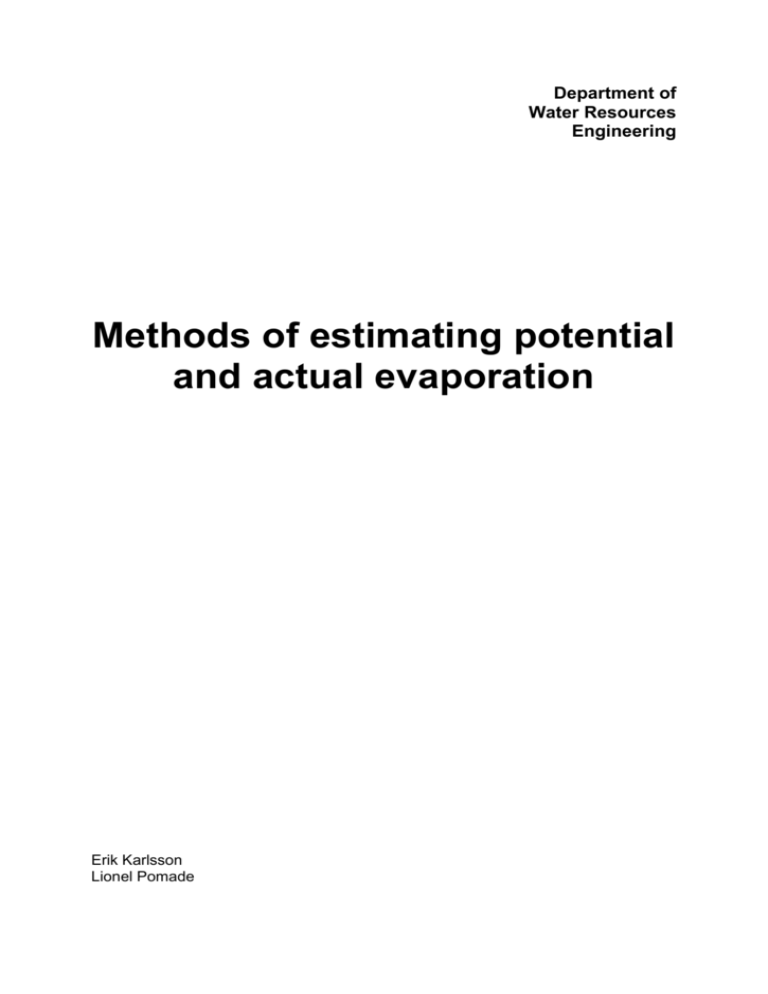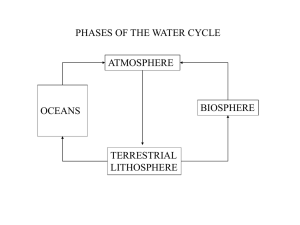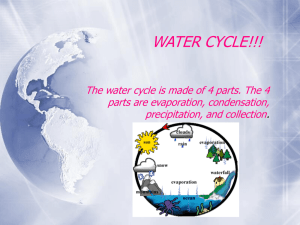Potential evaporation
advertisement

Department of Water Resources Engineering Methods of estimating potential and actual evaporation Erik Karlsson Lionel Pomade Summary This essay consists of the different methods of estimating both potential and actual evaporation. The different methods and equations like Penman equation and the method of percolation gauges are just two examples of what kind of processes there are to estimate evaporation which are explained in this text. The text is just a small inventory of the most common used methods and gives the reader a quick view of the knowledge behind evaporation. 1 Introduction Evaporation is the primary process of water transfer in the hydrogical cycle. The water is tranformed into vapour and transported of to the sky. The evaporation plus transpiration from a vegetated surface with unlimited water supply is known as potential evaporation or potential evapotranspiration (PE) and it constitutes the maximum possible rate due to the prevailing meteorological conditions. Thus PE is the maximum value of the actual evaporation (Et): PE = Et when water supply is unlimited. Actual evaporation is the amount of water which is evaporated a normal day which means that if for instance the soil runs out of water, the actual evaporation is the amount of water which has been evaporated, and not the amount of water which could have been evaporated if the soil had had an infinite amount of water to evaporate. Because of the variability of region and seasons, water managers who are responsible for planning and adjudicating the distribution of water resources need to have a thorough understanding of the evapotranspiration process and knowledge about the spatial and temporal rates of evapotranspiration. 2 2 Potential evaporation 2.1 Measurement of potential evaporation There are many different ways of measuring evaporation. One of the most common methods is to use the irrigated lysimeter. Other ones are the use of an atmometer and the standardised US Class A pan. 2.1.1 Irrigated lysimeter Potential evaporation, the evaporation plus transpiration from a vegetated surface when water supply is unlimited, can be measured using irrigated lysimeters. The installations used, shown in following figure, closely looks like a percolation gauge. The principal difference is in the operation of the apparatus, with the contained soil being kept at field capacity (the water content of the soil after the saturated soil has drained under gravity to equilibrum) by sprinkling a known quantity of water on the tank when rainfall is deficient. Field capacity is assured by maintaining continuous percolation from the bottom of the tank. Thus the vegetation cover is allowed to transpire freely, and the total evaporation loss is dependent entirely on the ability of the air to absorb the water vapour. Then: PE = Rainfall + Irrigation - Percolation Difficulties in operating: - One of the disadvantages of these gauges is that the soil sample is disturbed, but with careful filling of the tank and after the establishment of the vegetation cover, the gauge gradually becomes representative of the surrounding ground. - In winter with snow cover and freezing temperatures, certain difficulties in operating the gauges are encountered, but discrepancies are not of great importance since evaporation losses are low and often negligible under such conditions. - Measured values of PE using these irrigated gauges can be exaggerated in very dry periods and hot climates. Surrounding parches ground heating and drying the air above tends to cause increased evaporation from the continuously watered and transpiring vegetation of the gauge. (Shaw, 1994) 3 2.1.2 US class A pan There are a lot of standardized pans for measuring evaporation and the US Class A pan is probably the most used. The pan is circular with a diameter of 1.21 m and depth of 255 mm which gives it a volume of about 0.3 m3. The basin is put on a 150 mm high wooden frame due to air circulation around the basin. The water level is kept about 50 mm below the rim, due to allowance of percolation and the need of water. The water level is measured every day, either you measure the difference between the present and the origin water level or if you have chosen to obtain the water level in the pan, you measure the amount of water you’ve put into the pan. Due to that the sun hits the sides of the pan, the temperature gets higher which means that the evaporation gets higher than the actual evaporation. To correct this value you multiply your evaporation value from the pan with a coefficient, called pan coefficient and it’s value depends on what climate region your test have been taken. Another kind of pan is the UK British Standard tank which is a bit larger than the American pan and put on the same level as the ground. The principle is about the same as with the American pan. Though the general opinion in the UK is that measurement is unreliable and calculations are more common (Shaw, 1994). 2.1.3 Atmometer This is a device that can give direct measurement of evaporation. Atmometers basically consist of a wet, porous ceramic cup mounted on top of a cylindrical water reservoir. The ceramic cup is covered with a green fabric that simulates the canopy of a crop. The reservoir is filled with distilled water that evaporates out of the ceramic cup and is pulled through a suction tube that extends to the bottom of the reservoir. Underneath the fabric, the ceramic cup is covered by a special membrane that keeps rain water from seeping into the ceramic cup. A rigid wire extending from the top keeps birds from perching on top of the gauge (http://www.colostate.edu, 2003-10-02). Atmometer placed between fields. irrigated 4 2.2 Calculation of Potential Evaporation A value of the actual evapotranspiration (Et) over a catchment is more often obtained by first calculating the potential evapotranspiration (PE), assuming an unrestricted availability of water, and then modifying the answer by accounting for the actual soil moisture content. There are several formulae for calculating potential evaporation (based on theoretical or empirical models), but the most commonly used are the following ones: Penman equation: This equation directly results from the basic formula which allowed to estimate evaporation from an open water surface. Then: * QET * E at (mm/day) PE Where: QET = QS*(1 - r) - Ql Ql = 0.95*[8.64*107/(ρ*λ)]*σ*(273.16+Ta)4*(0.53+0.065*(ed1.0)1/2)*(0.10+0.90*(n/N)) Eat = 0.3*(1+0.5*u2)*(ea-ed) Δ (mb/C) is the the slope of the saturation vapour pressure curve with respect to temperature. γ is the hygrometric constant (=0.65 mb/C). Ql is long wave radiation from the water body. r is a coefficient relating to vegetation cover (r = 0.25 for a short grassed surface). Ta is air temperature (C). n/N is the ratio of actual/possible sunshine hours of bright sunshine. ρ is the density of water (kg/m3). λ is the latent heat of evaporization of water (J/kg). σ is Stefan Bolzman's constant (= 5.7*10-8 W/(m2*grad4)). u2 is wind velocity (m/s). ea is the saturation vapour pressure for the measured air temperature (mb). ed is the actual vapour pressure of the air (mb). OBS: QET, Qs, Ql, Eat are all expressed in mm/day. (Lecture notes) Thornthwaite's formula: This formula is based mainly on temperature with an adjustment being made for the number of daylight hours. An estimate of the potential evapotransiration, calculated on a monthly basis, is given by: a _ 10 T m PEm 16 N m mm I where m is the months 1, 2, 3…12, Nm is the monthly adjustment factor related to hours of daylight, Tm is the monthly mean temperature (C), I is the heat index for the year, 1.5 _ T given by: I im m for m = 1…12 5 -7 3 and: a = 6.7*10 *I - 7.7*10-5*I2 + 1.8*10-2*I + 0.49 5 Given the monthly mean temperatures from the measurements at a climatologgical station, an estimate of the potential evaporation for each month of the year can be calculated. This method has been used widely throughout the world, but strictly is not valid for climates other than those similar to that area where it was developed (the eastern USA). Compared to the Penman formula, Thornthwait values tend to exaggerate the potential evaporation. This is particularly marked in the summer months with the high temperatures having a dominant effect in the Tornthwaite computation, whereas the Penman estimate takes into consideration other meteorological factors. (Lecture notes) Turc's formula: Toward the needs of the agronomists for irrigation schemes, Turc extended his empirical method for calculating the annual actual evapotranspiration to produce a formula for potential evaporation over a shorter period of time. The Turc short term formula for potential evaporation over 10 days is: PE P a 70 P a 70 2 1 2 L L 0.5 mm where P is the precipitation in a 10 day period (mm), a is the estimated evaporation in the 10-day period from the bare soil when there has been no precipitation (1mm≤ a ≤ 10mm), and L is the "evaporation capacity" of the air given by: L T 2Qs 0.5 16 with T the mean air temperature over the 10 days (C) and Qs the mean short wave radiation (cal cm-2 day-1). (Shaw, 1994) Blaney-Criddle formula: This formula, based on another empirical model, requires only mean daily temperatures T (C) over each month. Then: PE p.(0.46.T 8) mm/day where p is the mean daily percentage (for the month) of total annual daytime hours (Lecture notes). 3 Actual evaporation 6 To estimate a value on the actual evaporation for an area you have a couple of different choices. You could either put up a water balance for the area, measure the water flow or you could put up an equation of the potential evaporation times a function depending on the amount of water available (Lecture notes). 3.1 Evaporation from soils The water which evaporates from a soil is stored in the small pores between the particles in the ground. When a rainfall hits the ground the pores are filled up with water, most of it infiltrates to the ground water or is led to a water course. From the point of field capacity, i.e. the amount of water which the soil manages to hold after free drainage, to the moment of wilking point, the water is accessible for evaporation (if the water content gets larger than the field capacity the process is called evaporation from free water surface). During this time we have had a pressure drop from corresponding -10 cm to -1000 m (Bengtsson, 1997). 3.2 Transpiration Water is not just evaporating from open water or from the soil, but also from vegetation. This is called transpiration, or together with the evaporation, evapotranspiration. Transpiration takes place through leaves pores, which are called stomata. The amount of vapour released from the pore depends of the temperature of the leaf, light and the amount of water in the leaf. All together these factors are called Stomata-resistance, rs. The value rs is raised at dry weather or if the content of water in the vegetation is low. We will write more about this factor further down when we write about the Penman-Monteith formula (Ward, 1999). 3.3 Calculation of actual evaporation There are a few formulas which are more common than others. In this chapter will we just write about the Penman-Monteith formula because it’s the most known and most used formula when it’s about calculating evapotranspiration. The origin of the equation is the Penman equation and later Monteith developed the formula even more. 3.3.1 Penman-Monteith The most known formula for evapotranspiration is the Penman-Monteith formula, ET where Rn ( e a e d ) * ( *(1 *c p ra rs )) ra Rn = net radiation (W/m2) ρ = density of air cp = specific heat of air rs = net resistance to diffusion through the surfaces of the leaves and soil (s/m) ra = net resistance to diffusion through the air from surfaces to height of measuring instruments (s/m). γ = hygrometric constant Δ = de/dT 7 ea = saturated vapour pressure at air temperature ed = mean vapour pressure The method is of quite good accuracy and is usually used for calculations of evapotranspiration from farmlands. The good accuracy is due to all the parameters of the equation but still it isn’t perfect. For instance, the rs value is a constant depending on what kind of vegetation the area holds. If the equation is used over a large area with different kind of vegetation you have to estimate a value for rs. The estimation gets even more non accurate if the area contains spots without vegetation. (Ward, 1999) 3.4 Methods for measuring actual evaporation Measuring actual evaporation is probably not as common as measuring potential. The most common method is the percolation gauge. Picture of percolation gauge The percolation gauge is actually regarded as a research tool and not a standard instrument for measuring evaporation and transpiration. There are many different designs of the gauge but the one on the picture is recommended. On the left side can we see a 1 meter deep hole filled up with soil, rock and gravel and a pipe from the bottom to the collection pit. The top of the hole should be indistinguishable from the surrounding vegetation. When you measure evaporation with a percolation gauge, you take no consideration to changes in soil water storage. That means that the measurements should be made over a time period when the gauge is saturated. Another method to measure evapotranspiration is with a lysimeter which takes consideration to how much water is stored in the soil. The lysimeter weigths the soil and gives a value on how much water is stored. This method is more complex, expensive and harder to maintain than percolation gauges. (Shaw, 1994) 4 Estimating evapotranspiration from satellite data When a surface evaporates, it looses energy and cools itself. It is that cooling that can be observed from space. Satellites can map the infrared heat radiated from Earth, thus 8 enabling to distinguish the cool surfaces from the warm surfaces. Very dry and desert-like surfaces show easily as they get hotter than their surroundings. From this qualitative reasoning, the scientific objective is to determine quantitatively the amount of evapotranspiration that occurs at given locations. In practice, it consists in entering various types of satellite observations (not just infrared) into mathematical models of the atmosphere. The models, of various complexities, are run in algorithmic form on computers. - Here is an example of the data set produced by AHN and Tateishi (Remote Sensing and Image Research Center, Chiba University, Japan): It consists of estimated monthly actual evapotranspiration. Estimation was based on the Priestley-Taylor method using global data sets including air temperature, albedo, cloudiness, elevation, which are parts of Global Ecosystems Database supplied by NOAAEPA. Then further calculation was conducted on Thornthwaite method to estimate evapotranspiration using precipitation (supplied by NOAA-EPA) and soil water holding capacity (supplied by GRID-Geneva) data. (http://www-cger.nies.go.jp, 2003-10-02) 5 Estimating actual evapotranspiration from potential The calculation of potential evaporation (PE) from readily available meteorological data is seen to be much simplier operation than the computation or measurement of actual evapotranspiration (Et) from a vegetated surface. However, water loss from a catchment area does not always proceed at the potential rate, since this is dependent on a continuous water 9 supply. When the vegetation is unable to abstract water from the soil, then the actual evaporation becomes less than potential. Thus the relationship between Et and PE depends upon the soil moisture content. - Here is an example of the relationship between PE and Et, according to Bergström, 1992: Et = PE h hW P Et PE. hFC hW P Et = 0 when h ≥ hFC when hWP < h < hFC when h ≤ hWP Where: h is the amount of soil moisture (mm). hFC is the amount of soil moisture corresponding to field capacity (mm). hWP is the amount of soil moisture corresponding to the wilting point (mm). (Lecture notes) - Others relations: On the graph to the right we can see the relationship between PE and Et according to: Veihmeyer and Hendrickson on line A, Thornthwaite on line B and Penman on curve C (Ward, 1999). 6. Conclusion The knowledge of evaporation has become more and more important during the last decades because of the increased use of irrigation on farmlands. 10 Estimating an exact value for evaporation over an area is very hard due to the unsecure parameters you have to take into account. Many models have been made, but most of them are based on empirical models and are therefore not very accurate. The most common model is the Penman equation which is widely used. It uses many parameters that are of great interest and involve many devices to calculate evaporation. Today the use of satellites permits estimation of evaporation over a larger area than we were able to estimate a decade ago. But we still integrate the parameters into the modelling equations to get a value of the evaporation. 7. References Ward and Robinson, Principles of Hydrology, 1999 Shaw M Elizabeth, Hydrology in Practice, 1994 Bengtsson Lars, Hydrologi - teori och processer, 1997 Lecture notes from 16/9-03, Joakim Malm http://www.colostate.edu/Depts/SoilCrop/extension/Newsletters/1999/gujune99.htm#Focus, 2003-10-02 http://www-cger.nies.go.jp/grid-e/gridtxt/tateishi.html, 2003-10-02 11







